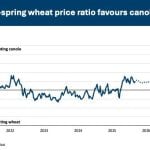Producers who wonder why their cattle aren’t performing well on pasture might want to take a closer look at their water source.
Poor water quality can have a dramatic effect on a herd’s performance, says an Agriculture Canada researcher in livestock management, and high levels of sulfates could be one of the culprits.
“When the water is not of good quality, they go in, they lick, they taste and they fuss around,” Doug Veira said during the Manitoba Grazing School in Brandon earlier this month.
Read Also

Beef cattle more prone to trace mineral deficiencies
The trace mineral status of our cows and calves is a significant challenge for western Canadian producers and veterinarians.
“They don’t have any enthusiasm for the water.”
Daily water intake could decline and producers could see poorer weight gains on their calves.
“If they don’t drink, they don’t eat,” Veira said.
An experiment done near Kamloops, B.C., in the late 1990s demonstrated the effects that high sulfate levels can have on weight gain. A dramatic difference was found between the weight gains of yearling heifers given access to clean water compared to those drinking from a dugout high in salts.
In 1998, sulfate levels in the dugout rose from 6,730 parts per million at the start of the summer trial to 17,600 ppm by the end of the trial. The three-fold increase in sulfate concentrations was due to the dry, hot weather experienced that year in the Kamloops area.
Heifers drinking the dugout water lost weight that summer. By comparison, heifers drinking clean water but grazing the same kind of pasture had an average daily gain of 1.55 pounds per day.
In 1999, the heifers drinking from the dugout had an average daily gain of 1.98 lb. The sulfate levels in the dugout were considerably lower, partly due to more spring runoff than in the previous year. However, the heifers drinking clean water with almost no sulfates still performed better, posting average daily gains of 2.62 lb. per day.
By observing the behaviour of cattle when drinking from a dugout or pond, producers might get a sense of whether salts are affecting water consumption, said Veira, who is stationed at Agriculture Canada’s Pacific Agri-Food Search Centre in Agassiz, B.C. Water quality can be more closely analyzed by sending samples to a recognized lab that offers a water analysis package.
“If in doubt, take a sample.”














